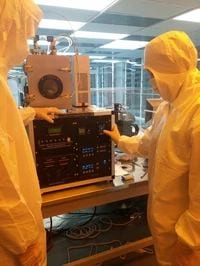Skip to content
Laboratory:
(II) Major Equipment
1. A home-build fiber TERS setup
A home-built STM was constructed that is capable of accepting optical fibers as probe tips. The fiber-capable STM consists of five main components: A scan block, piezo scan tube, sample positioning stage, fiber coupler, and RHK R9 STM control electronics.

2. UHV Scanning Tunneling Microscope (STM) apparatus
A SPECS variable temperature STM is used for sample morphology characterization. The sample temperature ranges from 100 K to 1500 K. It has the capability of in situ dosing of the gas molecules and in situ light irradiation on the sample when it is at the STM measurement position.
Its fast scanning capability (150000 pixels/s), achieved by high resonance frequencies of the scanner head is an ideal tool for probing chemical dynamics on the nanoscale. The high-pressure mercury lamp (Oriel Corporation) will be used to irradiate the samples. Besides STM, the ultrahigh vacuum apparatus is equipped with quadrupole mass spectrometry with standard sample cleaning facilities, an ion sputter gun, and a high-temperature effusion cell along with standard sample cleaning facilities.

3. Ultra-High-vacuum (UHV) Tip-enhanced Raman apparatus
A home-built optical-STM apparatus at BRIC is used for the UHV TERS study. The apparatus consists of a UHV preparation/analysis chamber, a dedicated UHV STM (RHK) chamber (a), and a home-build optical Raman setup (b). The chamber is equipped with a UV source and a gas delivery system. The base pressure is 10-11 Torr. The STM utilizes a “walker” scan head mounted over a sample holder. This arrangement minimizes the temperature- and pressure-induced drifts. The UHV TERS setup has been successfully tested by resolving 2 nm thick copper phthalocyanine (CuPc) Raman peaks on an Au(111) single crystal.
The STM sample preparation and characterization will be carried out in the standard UHV system equipped with an e-beam evaporator, quadrupole mass spectrometry, ion sputtering gun, low energy electron diffraction, and Auger Electron spectroscopy. The UHV chamber is equipped with a dedicated thermal evaporator to prepare monolayers of molecules on well-defined thin film samples. A doser is available inside the UHV chamber for dosing molecules onto the substrates.

4. High-pressure STM apparatus
An Omicron STM is modified for the controlled ambient pressure environment fiber TERS study. The apparatus will be operated at atmospheric pressure. The STM has a dedicated high-pressure STM chamber. The chamber is equipped with a gas delivery system. The pressure can be pressurized with reactive gas.

5. Physical vapor deposition chamber
A UHV chamber is designed for the deposition of CuPc, and other molecules onto substrates. The chamber is equipped with a low-temperature effusion cell (NTEZ 40-10-22), which will be used to evaporate and form molecular thin films on various substrates. The effusion cell technology (with temperature monitoring and feedback systems included) ensures highly controllable and reproducible evaporation of various materials. This equipment can heat source materials up to 800 °C. A quartz crystal sensor will be used to calibrate the actual flux of molecular beams. The team has previously used this system to deposit CuPc molecules onto MoS2 and polycarbon nanotubes.

Shared Facilities
6. A Bruker (Veeco) Multimode V scanning probe microscope (SPM)
Brucker is one of the leading companies in SPM. The multimode SPM is the most versatile SPM that has the capability of heating, cooling, gaseous environmental control, and electrochemical control.

7. Transmission measurement setup. For measuring transmission spectrum, polarization, and angular properties of the fiber. The measurement setup can be equipped with objective lens (100x, 60x, 40x, 20x) to focus on to the plasmonic fiber tip.

8. Transmission and reflection Michelson interferometry setup for phase and amplitude measurements. The measurement setup can be equipped with objective lens (100x, 60x, 40x, 20x) to focus on to fiber facet. Currently, the setup is operating in reflection mode. It will be modified to measure the reflected/transmitted phase, amplitude, polarization, and focusing as mentioned in the proposal.

9. Ultrafast nonlinear pump-probe setup. For measuring time-resolved nonlinear effects of the TERS measurements (e.g. Coherent Anti-stoke Raman Scattering (CARS). The setup contains a delay line for both pump and probe laser paths.


10. 50kV Electron Beam Lithography System
With the recently awarded NSF MRI fund, we will install a high-performance Electron Beam Lithography System at Baylor University with a budget of ~ $1M. The Ebeam lithography system provides reliable and powerful methods to create patterns with sub-10 nm resolution in a large area. The tool provides ultrahigh resolution patterning (<8 nm) in combination with the highest level of automation for complex applications. We will use the Ebeam lithography system to fabricate nano-antenna on fiber and to pattern nanostructures near the metallic tip for the TERS fiber applications. The patterning of 2D materials for TERS experiments will also be investigated.
Figure. 50kV High-Performance Electron Beam Lithography System (RAITH VOYAGER100). To be purchased and installed at Baylor University. Expected installation in April 2019.

10. Baylor class 1,000 cleanroom
The Ebeam lithography system will be housed in the class 1,000 cleanroom at Baylor University in the Baylor Research and Innovation Collaborative (BRIC). BRIC at Baylor University is a recently renovated facility of the old General Tire & Rubber Company plant in Waco, TX, and provides spacious 330,000-square-foot shared space for research, academy/industry collaborations, workforce training, symposia, and community events (Figure 1). A new class 1,000 cleanroom (a 972 sq. ft. multi-user facility with a 192 sq. ft. class 10,000 gowning area) has recently been constructed as shown in Figure 2. Part of the materials and thin film depositions will also be performed in the cleanroom facility.


Baylor Cleanroom at BRIC













